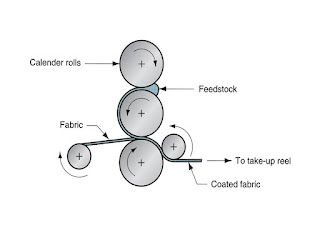Rubber Cloth Coating
Cloth
coating
Introduction
Cloth coating involves the
impregnation of cloth, mostly synthetic rather than cotton, with a rubber
solution to produce a waterproof or
chemically resistant fabric for use in waterproof clothing, tarpaulins, sails,
dinghy fabrics etc.
A range of rubbers and organic solvents are used to produce the rubber solution or 'dough'.
A range of rubbers and organic solvents are used to produce the rubber solution or 'dough'.
Natural rubber, synthetic
polymers such as chlorosulphonated polythene (Hypalon) and urethanes are the most widely used rubbers.
Commonly used organic solvents include toluene, xylene, acetone, MEK, and petroleum naphtha blends (n-hexane based) SBPs 1-5.
Commonly used organic solvents include toluene, xylene, acetone, MEK, and petroleum naphtha blends (n-hexane based) SBPs 1-5.
Rubber compound, produced
by internal or open mill mixing, is soaked in solvent before mixing to a
solution with the consistency of
light dough. Colours, other additives and more solvent may be added during
mixing.
Some fabrics such as nylon require pre-treatment to achieve a good bond with the rubber. MDI is most widely used as a pre-dip, prior to the spreading process. Most fabrics are pre-dried, usually in a hot air oven, prior to coating.
Spreading machines evenly
distribute the rubber solution onto the cloth as it is drawn under it, using an adjustable blade, known as
a doctor blade. The coated fabric is then drawn into a drying oven to evaporate the solvent. The cloth is
then passed over cooling rolls and wound up, either at the front or back of the machine.
Embossing rollers positioned after the oven produce the desired surface finish. process is usually repeated a number of times to achieve the required degree of proofing; the coating thickness at each
Embossing rollers positioned after the oven produce the desired surface finish. process is usually repeated a number of times to achieve the required degree of proofing; the coating thickness at each
pass is controlled by
adjusting the height of the doctor blade.
The rubber solution is fed
onto the cloth via a trough or tray. Solutions that are more viscous are added
as a 'roll' of material
directly onto the cloth and adjacent to the doctor blade. The speed of coating
machines can vary considerably, from
less than 10 metres per minute to over 100 metres per minute.
The slower, usually older, spreaders often have steam-heated chests to drive off the solvent. High speed machines tend to use indirect gas-fired evaporating ovens.
The slower, usually older, spreaders often have steam-heated chests to drive off the solvent. High speed machines tend to use indirect gas-fired evaporating ovens.
The coated cloth can be
vulcanised by either continuous curing, eg Rotocure, or more commonly by
dusting the coated cloth with a
starch based agent to prevent sticking and then re-rolling it and curing it in
batches in a steam autoclave.



Comments
Post a Comment